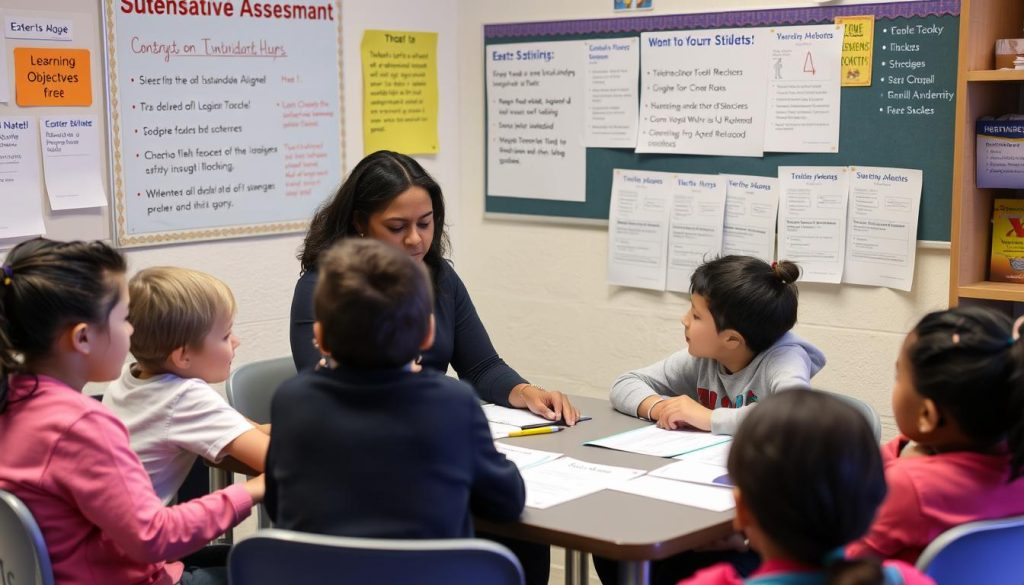The Importance of Standards in Creating Consistent Expectations
One of the primary benefits of educational standards is the establishment of consistent expectations across classrooms, schools, and districts. When all teachers work from the same set of standards, students receive a more equitable education regardless of where they live or which teacher they have.
Standards provide clarity about what students should know and be able to do at each grade level. This clarity helps you as a teacher to focus your instruction on essential knowledge and skills rather than trying to cover everything superficially. The development of teacher skills related to standards implementation enables you to translate these broad expectations into effective daily lessons.
According to a study by the RAND Corporation, teachers who thoroughly understand their state standards are better equipped to design coherent learning experiences. This understanding is a fundamental teacher skill that impacts every aspect of classroom instruction.
“Standards form the fundamental building blocks for educational development by establishing consistent protocols that can be universally understood and adopted.”
When you align your teaching with well-defined standards, you create a more predictable learning environment where students understand what’s expected of them. This predictability reduces anxiety and helps students focus on learning rather than trying to figure out what will be on the test.
Enhance Your Standards Implementation Skills
Looking to improve your teacher skills in standards implementation? Our comprehensive course provides practical strategies for integrating standards effectively into your daily teaching practice.
How Standards Drive Curriculum Alignment and Coherence
Educational standards provide the framework that ensures curriculum is aligned both horizontally (across subjects) and vertically (across grade levels). This alignment is crucial for building a coherent educational experience where each year builds logically upon previous learning.
For teachers, developing the teacher skills necessary to map standards to curriculum is essential. When you understand how your grade-level standards connect to what students learned previously and what they’ll need in the future, you can make more informed instructional decisions.

Standards-aligned curriculum helps eliminate gaps and redundancies in student learning. Without this alignment, students might miss critical concepts or waste time repeatedly covering the same material without appropriate advancement.
The importance of standards in curriculum development extends to resource selection as well. When you evaluate textbooks, digital tools, or supplementary materials, standards provide criteria for determining whether these resources will effectively support your instructional goals.
Developing teacher skills in curriculum mapping and alignment is a continuous process that pays dividends in more effective instruction. Teachers who can skillfully connect standards to daily lessons create more purposeful learning experiences.
The Importance of Standards in Assessment Quality and Fairness
Standards provide the foundation for quality assessment practices by clearly defining what students should know and be able to do. This clarity enables the development of assessments that accurately measure student learning rather than peripheral factors.
For teachers, developing assessment literacy is a critical teacher skill that connects directly to standards implementation. When you deeply understand the standards, you can create assessments that truly measure the intended learning outcomes.
Benefits of Standards-Based Assessment
- Increased validity and reliability of assessment data
- Better alignment between instruction and evaluation
- More equitable measurement of student achievement
- Clearer communication about student progress
- More targeted identification of learning gaps
Teacher Skills for Quality Assessment
- Unpacking standards to identify assessable components
- Creating valid assessment items aligned to standards
- Developing rubrics that reflect standards criteria
- Using assessment data to inform instruction
- Providing standards-based feedback to students
The importance of standards extends to both formative and summative assessment practices. Standards help ensure that classroom assessments, district benchmarks, and state tests are measuring similar constructs, creating a more coherent assessment system.
When assessments are properly aligned to standards, they provide valuable information about student learning that can guide instructional decisions. This alignment is a fundamental aspect of assessment validity.
Improve Your Assessment Design Skills
Want to enhance your teacher skills in creating standards-aligned assessments? Explore our professional development opportunities designed specifically for K12 educators.
Standards as a Tool for Educational Equity and Access
One of the most compelling aspects of educational standards is their potential to promote equity. When all students are held to the same high expectations, regardless of their zip code, socioeconomic status, or other demographic factors, we take an important step toward educational justice.
The importance of standards in promoting equity lies in their role as a common baseline of expectations. Without standards, educational quality can vary dramatically between schools and districts, often disadvantaging students in under-resourced communities.

For teachers, developing the teacher skills necessary to implement standards equitably is essential. This includes learning how to differentiate instruction while maintaining high expectations for all students, regardless of their starting points.
“Standards provide a stable but continually evolving foundation that enables entire educational systems to develop and thrive, ensuring all students have access to quality learning opportunities.”
Research indicates that when teachers have strong teacher skills in standards implementation, achievement gaps can be narrowed. The key is using standards as a floor, not a ceiling, for student achievement.
Standards also promote transparency about educational expectations, empowering parents and communities to advocate for quality education. When expectations are clear and public, it’s easier to hold educational systems accountable for serving all students well.
The Importance of Standards in Teacher Professional Growth
Educational standards don’t just guide student learning—they also provide a framework for teacher professional growth. Understanding and effectively implementing standards requires the development of sophisticated teacher skills that enhance overall instructional effectiveness.
When teachers engage deeply with standards, they often develop greater content knowledge and pedagogical expertise. The process of unpacking standards, identifying the underlying concepts and skills, and designing aligned instruction pushes teachers to deepen their own understanding.
Content Knowledge
Standards implementation requires teachers to develop deep understanding of subject matter, often beyond what they learned in their preparation programs.
Pedagogical Expertise
Translating standards into effective instruction requires sophisticated teacher skills in instructional design and delivery.
Assessment Literacy
Standards-based education demands strong teacher skills in creating and interpreting assessments that accurately measure student learning.
The importance of standards for professional growth extends to teacher collaboration as well. When teachers work together to interpret standards and design aligned instruction, they create professional learning communities that enhance everyone’s practice.

Standards also provide a common language for professional discourse about teaching and learning. This shared vocabulary facilitates more productive collaboration and mentoring relationships among educators.
Advance Your Professional Growth
Ready to take your teacher skills to the next level? Our standards-focused professional development programs are designed by teachers, for teachers.
How Standards Drive Improved Student Achievement
The ultimate goal of educational standards is improved student learning outcomes. When properly implemented, standards can significantly impact student achievement by focusing instruction on essential knowledge and skills.
Research has shown that teachers who develop strong teacher skills in standards implementation see better results in their classrooms. The key is not just covering the standards but developing deep understanding of them and translating that understanding into effective instructional practices.
The importance of standards in driving student achievement lies in their focus on higher-order thinking skills and conceptual understanding rather than mere factual recall. Well-designed standards push students to develop the kind of deep learning that transfers to new situations.
For teachers, developing the teacher skills necessary to move beyond surface-level implementation of standards is crucial. This includes learning how to design learning experiences that engage students in the kind of complex thinking the standards demand.
“When students are confident that products will work as expected, they’re far more likely to buy them. Similarly, when students understand what’s expected of them academically, they’re more likely to succeed.”
Standards also help teachers identify and address learning gaps more effectively. When you have a clear progression of skills and knowledge, it’s easier to pinpoint exactly where a student is struggling and provide targeted support.
The connection between standards and student achievement is strongest when teachers develop the teacher skills to make standards meaningful and relevant to students. When students understand the purpose behind what they’re learning, engagement and achievement both increase.
The Importance of Standards in Fostering Innovation and Collaboration
Contrary to the misconception that standards stifle creativity, well-implemented standards actually create the conditions for innovation in teaching and learning. By establishing clear expectations for what students should learn, standards free teachers to be creative about how that learning happens.
The importance of standards in fostering innovation lies in their focus on outcomes rather than inputs. When standards define what students should know and be able to do without prescribing specific instructional approaches, teachers have the freedom to innovate in their practice.
Developing teacher skills in creative standards implementation is a mark of instructional expertise. The most effective teachers view standards not as constraints but as opportunities to design engaging, meaningful learning experiences.

Standards also facilitate collaboration among teachers by providing a common framework and language. When teachers across grade levels and subject areas understand how their work connects through standards, they can create more coherent learning experiences for students.
Innovation Benefits
- Freedom to design creative instructional approaches
- Focus on deeper learning rather than coverage
- Opportunity to personalize learning while maintaining high expectations
- Encouragement of problem-solving and critical thinking
Collaboration Benefits
- Common language for professional discourse
- Clearer connections between grade levels and subjects
- Shared understanding of learning progressions
- More effective vertical and horizontal alignment
The teacher skills required for collaborative standards implementation include effective communication, openness to feedback, and willingness to share resources and ideas. When teachers collaborate around standards, everyone’s practice improves.
Join Our Community of Innovative Educators
Connect with fellow teachers who are finding creative ways to implement standards while developing essential teacher skills.
Practical Strategies for Effective Standards Implementation
Understanding the importance of standards is just the beginning. Translating that understanding into effective classroom practice requires specific teacher skills and strategies. Here are practical approaches for implementing standards effectively in your classroom:
Unpack the Standards
Break down standards into component knowledge and skills. Identify the verbs (what students will do) and the content (what students will know). This teacher skill helps you understand exactly what students need to demonstrate.
Create Learning Progressions
Develop clear sequences showing how learning builds toward standards mastery. This teacher skill helps you scaffold instruction appropriately and track student progress effectively.
Design Aligned Assessments
Create assessments that directly measure the knowledge and skills in the standards. This teacher skill ensures you’re gathering valid evidence of student learning.

Effective standards implementation also requires the teacher skill of backward design—starting with the desired outcomes (standards) and working backward to design assessments and learning experiences. This approach ensures alignment throughout the instructional process.
Another essential teacher skill is making standards accessible to students. When students understand what they’re expected to learn and why it matters, they become more engaged and take greater ownership of their learning.
“Standards provide detailed information that saves teachers enormous amounts of time when developing lessons. They don’t have to create frameworks from scratch but can focus on creative implementation.”
The importance of standards becomes most evident when they’re implemented thoughtfully and skillfully. The most effective teachers develop the teacher skills to make standards meaningful and relevant in their specific classroom contexts.
Key Teacher Skills for Standards Implementation
- Analyzing standards to identify key concepts and skills
- Designing aligned instruction and assessment
- Differentiating instruction while maintaining high expectations
- Providing targeted feedback based on standards criteria
- Using assessment data to adjust instruction
Overcoming Common Challenges in Standards Implementation
While the importance of standards in education is clear, implementing them effectively isn’t without challenges. Understanding these challenges and developing the teacher skills to address them is essential for successful standards-based teaching.
Common Challenges
- Interpreting vague or complex standards language
- Balancing breadth and depth of coverage
- Differentiating instruction while maintaining standards alignment
- Finding high-quality, aligned instructional materials
- Managing time constraints while addressing all standards
Effective Solutions
- Collaborate with colleagues to interpret standards
- Prioritize standards based on endurance, leverage, and readiness
- Use flexible grouping and tiered assignments
- Evaluate resources using standards-alignment criteria
- Integrate standards across subject areas when possible
One of the most important teacher skills for overcoming these challenges is prioritization. Not all standards require equal instructional time—some represent foundational concepts that need deep exploration, while others may need less emphasis.

Another essential teacher skill is adaptability—being able to adjust instruction based on student needs while maintaining alignment with standards. This balance between flexibility and fidelity is at the heart of effective standards implementation.
The importance of standards doesn’t diminish in the face of implementation challenges. Rather, these challenges highlight the need for ongoing professional learning and collaboration among educators.
Master Standards Implementation Challenges
Our comprehensive course addresses common implementation challenges and helps you develop the teacher skills to overcome them.
Embracing the Importance of Standards in Your Teaching Practice
The importance of standards in education extends far beyond compliance or accountability. Standards provide the foundation for quality teaching and learning, offering clarity about educational goals and creating coherence across classrooms, schools, and districts.
As we’ve explored throughout this article, standards support equity, drive curriculum alignment, improve assessment quality, foster professional growth, enhance student achievement, and encourage innovation and collaboration. When implemented effectively, they become powerful tools for educational improvement.
Developing the teacher skills necessary for effective standards implementation is a career-long journey. The most successful educators view standards not as constraints but as frameworks that guide their professional practice while leaving room for creativity and personalization.
As you continue to refine your teacher skills related to standards implementation, remember that the ultimate goal is improved student learning. Standards are means to an end—tools that help us create more effective, equitable, and engaging educational experiences for all students.
The importance of standards in education will only continue to grow as our educational system evolves. By embracing standards as valuable professional tools and developing the teacher skills to implement them effectively, you position yourself as a leader in educational excellence.
Continue Your Professional Growth Journey
Ready to take your standards implementation to the next level? Explore our comprehensive resources designed to enhance your teacher skills and improve student outcomes.




